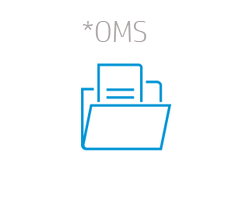
OMS files refer to the media profiles that are optimized to make a certain media work on a certain printer.
Every file is compressed, encrypted, and signed in case it will be published by HP, and is composed of 3 (or 4) main elements:
- Mechanical parameters set: these are the printer’s mechanical values, which make the media work on that specific printer. They are values for motors and sensors parameters. These are values pre-defined and characterized by R&D to cover a full family of substrates, such as self-adhesive vinyl, but also include others that the customer can modify through the user interface, like the media tension or the print zone vacuum.
- Color calibration reference: when a color calibration is done for the first time in a certain media from the IPS (Internal Print System) or the control panel, the printer automatically creates a reference. This is a list of the densities that this specific set of printheads is generating for every primary color. Every time the color calibration is run over this specific media, those densities will be taken as a reference to compensate the color losses due to printhead aging.
- Print modes: the list of all the print modes per each media, for example, 6p 100% 6c, 8p 120% 10c. Print modes determine the speed, the print quality and the color gamut that will be used.
- ICC profile: only for the HP Latex 300 and 500 Printer series. The ICC file is also stored inside the OMS file, although is always applied by the RIP. During the media synchronization process between the printer and the RIP, the RIP takes the ICC from the OMS.
The fact that the OMS files primarily determine the mechanical settings of the mechanics of the printer is what makes the files unable to be shared among printers of different families.
The OMS files are shareable across printers of the same family, for example, two different models of the HP Latex 300 series, or of the HP Latex 3000 series, but are not shareable among models of different Printer series.
There are 2 exceptions:
- The HP Latex 3000 printers can accept media files (*.oms) created or designed for the HP Latex 1500 and vice versa (the HP Latex 1500 printer can accept media files from the HP Latex 3000 printers). Both families share multiple mechanics making the media files completely shareable.
- The HP Latex 500 Printer series can accept media files from any third-generation HP Latex printer (HP Latex 3000, 300 and 500 Printer series and HP Latex 1500 printer). The HP Latex 500 series printers have been designed to be the universal HP Latex color emulator so they have been programmed with the internal tables that adapt other HP Latex family media settings to the HP Latex 500 series The HP Latex 500 Printer series behavior as a universal emulator will be explained in a separate document.
In short, OMS files (identified by the file extension .oms) are files defined by HP and used across all the HP large format products that store mechanical settings, print modes, color reference and, in some cases, ICC profiles. The fact that the mechanical settings are dependent on the product family makes unable the sharing of media files across printers with two exceptions: between the HP Latex 1500 printer and the HP Latex 3000 Printer series, and with the HP Latex 500 Printer series, that accepts OMS files from every 3rd generation HP Latex printer.










